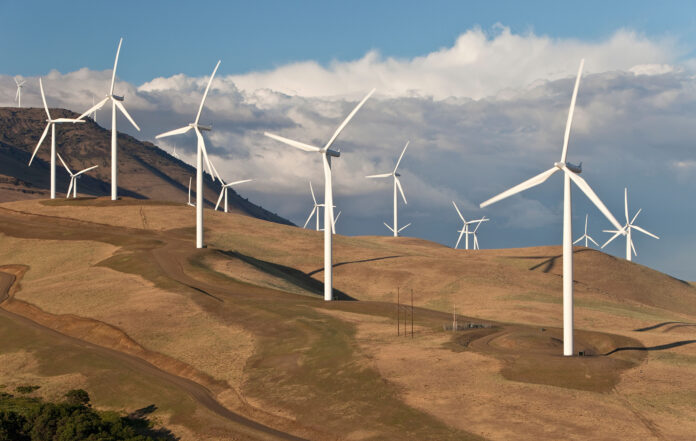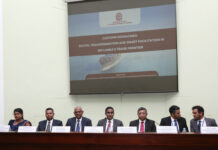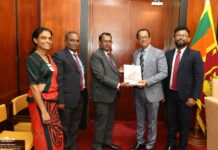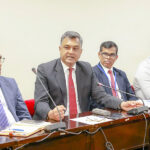By: Compiled by Gp Capt Kumar Kirinde, SLAF [retd]
A wind turbine is a device that converts the kinetic energy* of wind into electrical energy. As of 2020, hundreds of thousands of large turbines, in installations known as wind farms, were generating over 650 gigawatts of power, with 60 GW added each year.
In physics, the kinetic energy of an object is the form of energy that it possesses due to its motion
Wind turbines are an increasingly important source of intermittent renewable energy, and are used in many countries to lower energy costs and reduce reliance on fossil fuels. One study claimed that, as of 2009, wind had the “lowest relative greenhouse gas emissions, the least water consumption demands and the most favorable social impacts” compared to photovoltaic, hydro, geothermal, coal and gas energy sources. Smaller wind turbines are used for applications such as battery charging and remote devices such as traffic warning signs. Larger turbines can contribute to a domestic power supply while selling unused power back to the utility supplier via the electrical grid. Wind turbines are manufactured in a wide range of sizes, with either horizontal or vertical axes, though horizontal is most common.
History
The windwheel of Hero of Alexandria (10–70 CE), a Greek mathematician and engineer who was active in Alexandria in Egypt during the Roman era, marks one of the first recorded instances of wind powering a machine. However, the first known practical wind power plants were built in Sistan, an Eastern province of Persia (now Iran), from the 7th century. These wind mills were used to grind grain or draw up water, and were used in the gristmilling (grinding cereal grain into flour) and sugarcane industries.
The first electricity-generating wind turbine was installed by the Austrian Josef Friedländer at the Vienna International Electrical Exhibition in 1883. It was a Halladay windmill for driving a dynamo. Friedländer’s Halladay “wind motor” was supplied by U.S. Wind Engine & Pump Co. of Batavia, Illinois. The 3.7 kW (5 hp) windmill drove a dynamo at ground level that fed electricity into a series of batteries. The batteries powered various electrical tools and lamps, as well as a threshing machine.
In July 1887, Scottish academic James Blyth installed a battery-charging machine to light his holiday home in Marykirk, Scotland.
Some months later, American inventor Charles F. Brush was able to build the first automatically operated wind turbine after consulting local University professors and his colleagues Jacob S. Gibbs and Brinsley Coleberd and successfully getting the blueprints peer-reviewed for electricity production.
A forerunner of modern horizontal-axis wind generators was in service at Yalta, USSR, in 1931. This was a 100 kW generator on a 30-meter (98 ft) tower, connected to the local 6.3 kV distribution system. It was reported to have an annual capacity factor of 32 percent, not much different from current wind machines.
In the autumn of 1941, the first megawatt-class wind turbine was synchronized to a utility grid in Vermont. This Smith–Putnam wind turbine only ran for about five years before one of the blades snapped off. The unit was not repaired, because of a shortage of materials during the war.
The first utility grid-connected wind turbine to operate in the UK was built by John Brown & Company in 1951 in the Orkney Islands.
In the early 1970s, however, anti-nuclear protests in Denmark spurred artisan mechanics to develop microturbines of 22 kW despite declines in the industry. Organizing owners into associations and co-operatives led to the lobbying of the government and utilities and provided incentives for larger turbines throughout the 1980s and later. Local activists in Germany, nascent turbine manufacturers in Spain, and large investors in the United States in the early 1990s then lobbied for policies that stimulated the industry in those countries.
Types
Wind turbines can rotate about either a horizontal axis; horizontal-axis wind turbines (HAWT) or a vertical axis; vertical-axis wind turbines (VAWT), the former being both older and more common. They can also include blades or be bladeless.
Horizontal axis
Large three-bladed HAWT with the blades upwind of the tower produce the overwhelming majority of wind power in the world today. These turbines have the main rotor shaft and electrical generator at the top of a tower and must be pointed into the wind. Turbines used in wind farms for commercial production of electric power are usually three-bladed. The blades are usually colored white for daytime visibility by aircraft and range in length from 20 to 80 meters (66 to 262 ft).
Vertical axis
Vertical-axis wind turbines (or VAWTs) have the main rotor shaft arranged vertically. One advantage of this arrangement is that the turbine does not need to be pointed into the wind to be effective. Vertical turbine designs have much lower efficiency than standard horizontal designs. The one of the key disadvantages is the relatively low rotational speed.
Components
Wind turbines convert wind energy to electrical energy for distribution. Conventional horizontal axis turbines can be divided into three components:
The rotor, which is approximately 20% of the wind turbine cost, includes the blades for converting wind energy to low-speed rotational energy. The generator, which is approximately 34% of the wind turbine cost, includes the electrical generator, the control electronics, and most likely a gearbox (e.g., planetary gear box), adjustable-speed drive, or continuously variable transmission component for converting the low-speed incoming rotation to high-speed rotation suitable for generating electricity. The surrounding structure, which is approximately 15% of the wind turbine cost, includes the tower and rotor yaw mechanism.
Technology
Blade materials
Generally, efficiency increases along with turbine blade lengths. The blades must be stiff, strong, durable, light and resistant to fatigue. Materials with these properties include composites such as polyester and epoxy, while glass fiber and carbon fiber have been used for the reinforcing.
Non-blade materials
Wind turbine parts other than the rotor blades (including the rotor hub, gearbox, frame, and tower) are largely made of steel. Smaller turbines (as well as megawatt-scale Enercon turbines) have begun using aluminum alloys for these components to make turbines lighter and more efficient. Pre-stressed concrete has been increasingly used for the material of the tower, but still requires much reinforcing steel to meet the strength requirement of the turbine. Modern turbines use copper for generators and cables and such.
Costs
As of 2019, the capital cost of a wind turbine was around $1 million per megawatt of nameplate capacity, though this figure varies by location; for example, such numbers ranged from a half million in South America to $1.7 million in Asia.
For the wind turbine blades, while the material cost is much higher for hybrid glass/carbon fiber blades than all-glass fiber blades, labor costs can be lower. Using carbon fiber allows simpler designs that use less raw material. The chief manufacturing process in blade fabrication is the layering of plies. Thinner blades allow reducing the number of layers and thus the labor and in some cases, equate to the cost of labor for glass fiber blades. Offshore has significantly higher installation costs.
Maintenance
Wind turbines need regular maintenance to stay reliable and available. In the best case turbines are available to generate energy 98% of the time. Modern turbines usually have a small onboard crane for hoisting maintenance tools and minor components. However, large, heavy components like generators, gearboxes, blades, and so on are rarely replaced, and a heavy lift external crane is needed in those cases.
Comparison with other power sources
Advantages
Wind turbines is one of the lowest-cost sources of renewable energy along with solar panels. As technology needed for wind turbines continued to improve, the prices decreased as well. In addition, there is currently no competitive market for wind energy (though there may be in the future), because wind is a freely available natural resource, most of which is untapped. Usually, the total amount of energy harvested amount to more than the cost of the turbines.
Wind turbines provide a clean energy source, use little water, emitting no greenhouse gases and no waste products during operation. Over 1,400 tonnes (1,500 short tons) of carbon dioxide per year can be eliminated by using a one-megawatt turbine instead of one megawatt of energy from a fossil fuel.
Disadvantages
Environmental impact of wind power includes effect on wildlife, but can be mitigated if proper strategies are implemented. Thousands of birds, including rare species, have been killed by the blades of wind turbines, though wind turbines contribute relatively insignificantly to anthropogenic avian mortality.
Wind farms and nuclear power plants are responsible for between 0.3 and 0.4 bird deaths per gigawatt-hour (GWh) of electricity while fossil fuel power stations are responsible for about 5.2 fatalities per GWh. In comparison, conventional coal-fired generators contribute significantly more to bird mortality. A study on recorded bird populations in the United States from 2000 to 2020 found the presence of wind turbines had no significant effect on bird population numbers.
Energy harnessed by wind turbines is variable, and is not a “dispatchable” source of power; its availability is based on whether the wind is blowing, not whether electricity is needed. Turbines can be placed on ridges or bluffs to maximize the access of wind they have, but this also limits the locations where they can be placed. In this way, wind energy is not a particularly reliable source of energy. However, it can form part of the energy mix, which also includes power from other sources.
Wind turbines have blinking lights that warn aircraft, to avoid collisions. Residents living near windfarms, especially those in rural areas, have complained that the blinking lights are a bothersome form of light pollution. A light mitigation approach involves Aircraft Detection Lighting Systems (ADLSs)
by which the lights are turned on, only when the ADLS’s radar detects aircraft within thresholds of altitude and distance.
Conclusion
A few localities have exploited the attention-getting nature of wind turbines by placing them on public display, either with visitor centers around their bases, or with viewing areas farther away. The wind turbines are generally of conventional horizontal-axis, three-bladed design and generate power to feed electrical grids, but they also serve the unconventional roles of technology demonstration, public relations, and education.
Courtesy: Sources: https://en.wikipedia.org/wiki/Wind_turbine and Google Images
Document / article compiled and written by Gp Capt Kumar Kirinde, SLAF [retd]












